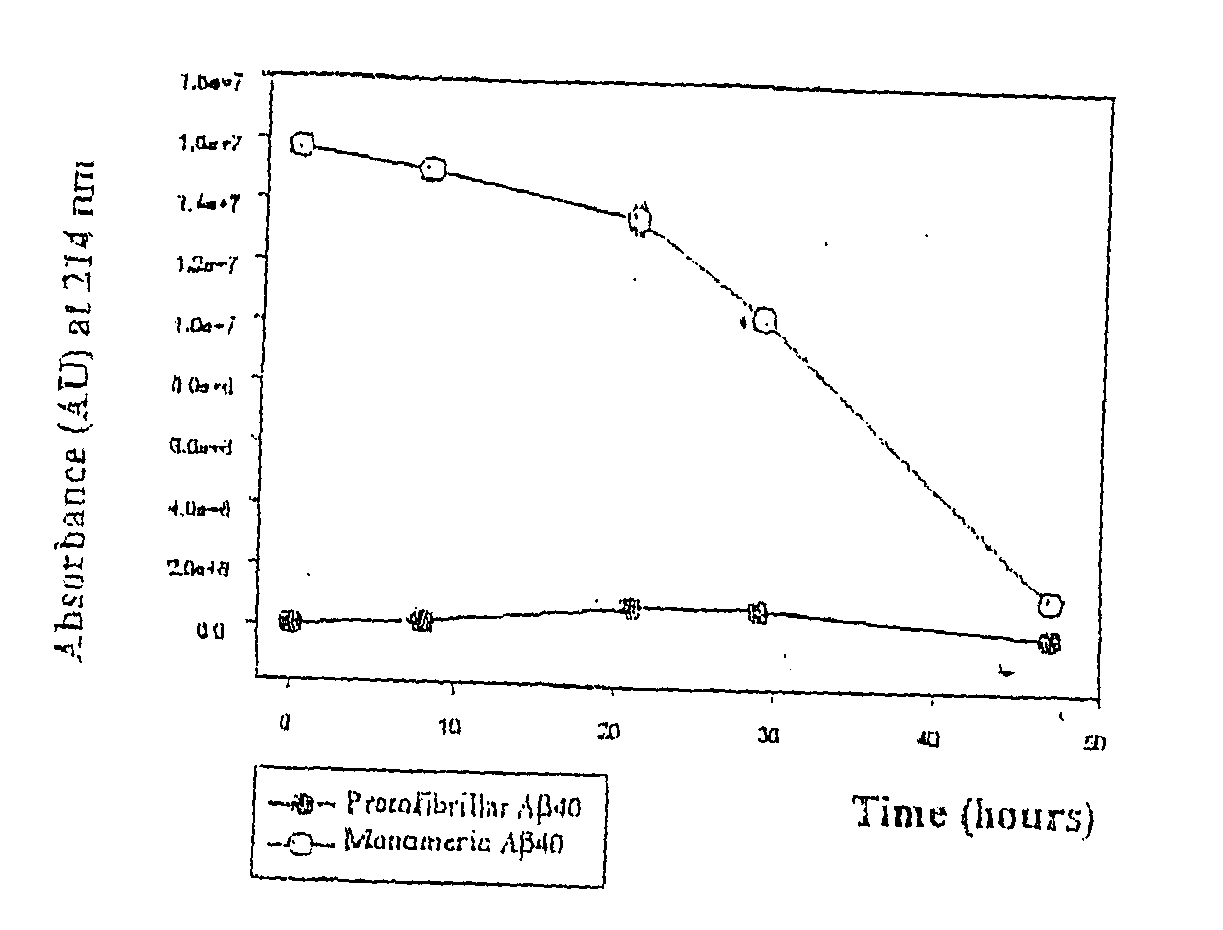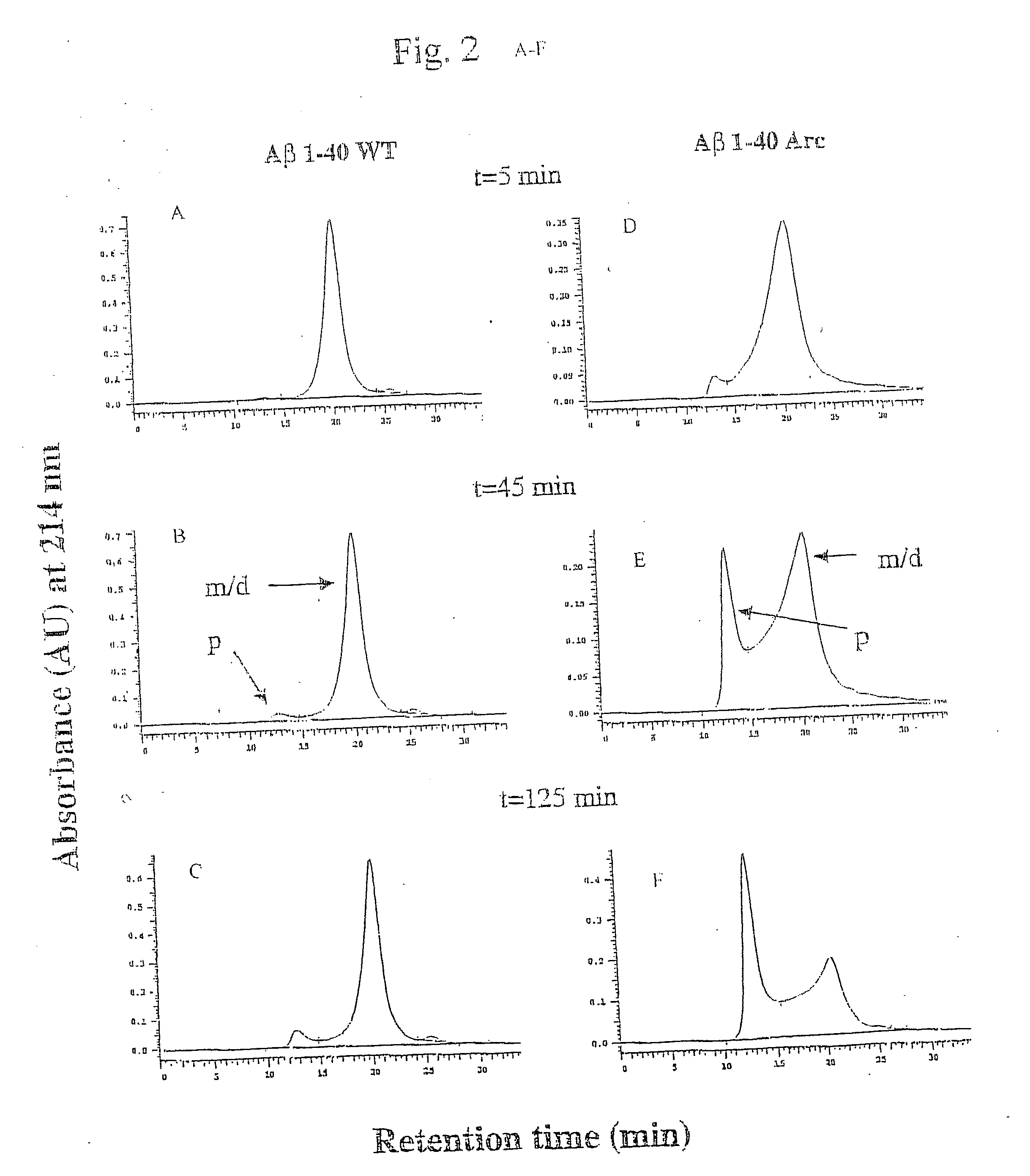Treatment of Alzheimer's disease
a technology for alzheimer's and treatment, applied in the field of prevention and treatment of alzheimer's disease, can solve the problem of only detection of mutations, and achieve the effect of improving the efficacy of ad treatmen
- Summary
- Abstract
- Description
- Claims
- Application Information
AI Technical Summary
Benefits of technology
Problems solved by technology
Method used
Image
Examples
example 1
Identification of the Arctic Mutation
[0053] An APP mutation (E693G) in a family from northern Sweden, named the “Arctic” family, is identified, which spans over four generations. The family was screened for mutations in exons 16 and 17 of the APP gene by single strand conformation polymorphism analysis (SSCP) (L. Forsell, L. Lannfelt, (1995)). An abnormal mobility pattern was observed in exon 17. Sequencing revealed an A→G nucleotide substitution, representing a glutamic acid to a glycine substitution at APP codon 693 (E693G), corresponding to position 22 in the A□ sequence. Venous blood was drawn into tubes containing EDTA and DNA was prepared according to standard procedures. SSCP was performed. To sequence exon 17 of the APP gene a 319 bp fragment was amplified with the following primers 5′-CCT CAT CCA AAT GTC CCC GTC ATT-3′ and 5′-GCC TAA TTC TCT CAT AGT CTT AAT TCC CAC-3′. The PCR products were purified with QIAquick PCR purification kit (Qiagen) prior to sequencing. Direct se...
example 2
Clinical Symptoms in Carriers of the Arctic Mutation
[0054] The family with the “Arctic” mutation was clinically and genealogically investigated. In this family, the mean age of onset was 56.6 years and the mean duration of the disease was 7 years (n=5).
[0055] The first symptom in most cases in this family was an insidious loss of memory for recently acquired information. Symptoms before clinical manifestation of Alzheimer's disease were decreased power of concentration and difficulties in handling stress situations. All affected individuals in generation IV had an early retirement pension because of the disease. The patients in generation IV were investigated by magnetic resonance imaging (MRI), computed tomography (CT) and electroencephalography (EEG) which confirmed the diagnosis of Alzheimer's disease. In four individuals CT and MRI did not demonstrate signs of stroke or cerebral haemorrhage.
example 3
Decreased Aβ Plasma Levels in Carriers of the Arctic Mutation
[0056] Pathogenic APP mutations have been shown to affect APP processing, as reflected in an increase of either total Aβ or Aβ42 in the plasma of affected family members. The Arctic mutation is located in a region different from other AD-causing mutations. It was investigated as to whether the mutation manifested itself by affecting Aβ plasma levels. Plasma from nine mutation carriers, of which four were symptomatic, and eleven non-carriers in the family, were analysed by well-characterized sandwich ELISA systems, specifically detecting Aβ42 (BAN50 / BC05) and Aβ40 (BAN50 / BA27) (Suzuki et al. 1994)). To reassure that the Arctic mutation did not change any of the antibody recognition sites Aβ40wt and Aβ40Arc peptides were tested and found to be recognized equally well. Furthermore, plasma was spiked with synthetic peptides, revealing that both AβArc and Aβwt peptides were recovered by ELISA to the same extent. The data obtai...
PUM
| Property | Measurement | Unit |
|---|---|---|
| insoluble | aaaaa | aaaaa |
| penetrating power | aaaaa | aaaaa |
| random coil structure | aaaaa | aaaaa |
Abstract
Description
Claims
Application Information
 Login to View More
Login to View More - R&D
- Intellectual Property
- Life Sciences
- Materials
- Tech Scout
- Unparalleled Data Quality
- Higher Quality Content
- 60% Fewer Hallucinations
Browse by: Latest US Patents, China's latest patents, Technical Efficacy Thesaurus, Application Domain, Technology Topic, Popular Technical Reports.
© 2025 PatSnap. All rights reserved.Legal|Privacy policy|Modern Slavery Act Transparency Statement|Sitemap|About US| Contact US: help@patsnap.com



